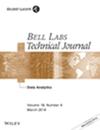Mobile Video Optimization at the Base Station: Adaptive Guaranteed Bit Rate for HTTP Adaptive Streaming
Harish Viswanathan, Danny De Vleeschauwer, Andre Beck, Steven Benno, Raymond B. Miller, Gang Li, Mark M. Clougherty, David C. Robinson
下载PDF
{"title":"Mobile Video Optimization at the Base Station: Adaptive Guaranteed Bit Rate for HTTP Adaptive Streaming","authors":"Harish Viswanathan, Danny De Vleeschauwer, Andre Beck, Steven Benno, Raymond B. Miller, Gang Li, Mark M. Clougherty, David C. Robinson","doi":"10.1002/bltj.21611","DOIUrl":null,"url":null,"abstract":"<p>Video is expected to be the dominant application by traffic volume over mobile networks in the near future. Mobile network operators are deploying video optimization techniques to enhance the user experience and network utilization for video delivery. Video optimization is typically “out-of-network” and includes techniques such as transcoding, transrating, time shifting and pacing that are implemented outside of mobile radio access and core networks. However, such techniques cannot easily exploit information about real time cell congestion and radio conditions for the video terminals because it is difficult to obtain such information from the radio access network. We propose a novel “in-network” video optimization technique, named Adaptive Guaranteed Bit Rate (AGBR), for HTTP-based Adaptive Streaming (HAS) video. This optimization technique is implemented at the base station and can thus exploit knowledge of the radio and congestion conditions. With only limited knowledge of the video stream properties or content, AGBR works by adjusting the throughput delivered to the different HAS clients that in turn adjust the video quality they request. The optimization algorithm maximizes aggregate quality across multiple video flows served by the base station without starving data clients, thereby improving the overall quality of experience. We demonstrate through extensive analytical modeling and simulations that AGBR can adapt to changing network conditions to support more video sessions at an acceptable quality than alternative algorithms, while enforcing fairness among all users competing for resources within a sector. © 2013 Alcatel-Lucent.</p>","PeriodicalId":55592,"journal":{"name":"Bell Labs Technical Journal","volume":"18 2","pages":"159-174"},"PeriodicalIF":0.0000,"publicationDate":"2013-08-28","publicationTypes":"Journal Article","fieldsOfStudy":null,"isOpenAccess":false,"openAccessPdf":"https://sci-hub-pdf.com/10.1002/bltj.21611","citationCount":"5","resultStr":null,"platform":"Semanticscholar","paperid":null,"PeriodicalName":"Bell Labs Technical Journal","FirstCategoryId":"1085","ListUrlMain":"https://onlinelibrary.wiley.com/doi/10.1002/bltj.21611","RegionNum":0,"RegionCategory":null,"ArticlePicture":[],"TitleCN":null,"AbstractTextCN":null,"PMCID":null,"EPubDate":"","PubModel":"","JCR":"Q1","JCRName":"Engineering","Score":null,"Total":0}
引用次数: 5
引用
批量引用
Abstract
Video is expected to be the dominant application by traffic volume over mobile networks in the near future. Mobile network operators are deploying video optimization techniques to enhance the user experience and network utilization for video delivery. Video optimization is typically “out-of-network” and includes techniques such as transcoding, transrating, time shifting and pacing that are implemented outside of mobile radio access and core networks. However, such techniques cannot easily exploit information about real time cell congestion and radio conditions for the video terminals because it is difficult to obtain such information from the radio access network. We propose a novel “in-network” video optimization technique, named Adaptive Guaranteed Bit Rate (AGBR), for HTTP-based Adaptive Streaming (HAS) video. This optimization technique is implemented at the base station and can thus exploit knowledge of the radio and congestion conditions. With only limited knowledge of the video stream properties or content, AGBR works by adjusting the throughput delivered to the different HAS clients that in turn adjust the video quality they request. The optimization algorithm maximizes aggregate quality across multiple video flows served by the base station without starving data clients, thereby improving the overall quality of experience. We demonstrate through extensive analytical modeling and simulations that AGBR can adapt to changing network conditions to support more video sessions at an acceptable quality than alternative algorithms, while enforcing fairness among all users competing for resources within a sector. © 2013 Alcatel-Lucent.
基站移动视频优化:HTTP自适应流的自适应保证比特率
在不久的将来,视频预计将成为移动网络流量的主要应用。移动网络运营商正在部署视频优化技术,以提高视频传输的用户体验和网络利用率。视频优化通常是“网外”的,包括在移动无线接入和核心网络之外实现的转码、翻译、时移和节奏等技术。然而,由于难以从无线接入网获得实时蜂窝拥塞和视频终端的无线电条件信息,因此这种技术不能很容易地利用这些信息。针对基于http的自适应流(HAS)视频,我们提出了一种新的“网络内”视频优化技术,称为自适应保证比特率(AGBR)。这种优化技术是在基站上实现的,因此可以利用无线电和拥塞条件的知识。由于对视频流属性或内容的了解有限,AGBR通过调整交付给不同HAS客户端的吞吐量来工作,从而调整它们所要求的视频质量。优化算法最大限度地提高了基站服务的多个视频流的综合质量,而不会使数据客户端挨饿,从而提高了整体体验质量。我们通过广泛的分析建模和模拟证明,AGBR可以适应不断变化的网络条件,以可接受的质量支持比其他算法更多的视频会话,同时在扇区内竞争资源的所有用户之间强制公平。©2013阿尔卡特朗讯
本文章由计算机程序翻译,如有差异,请以英文原文为准。


